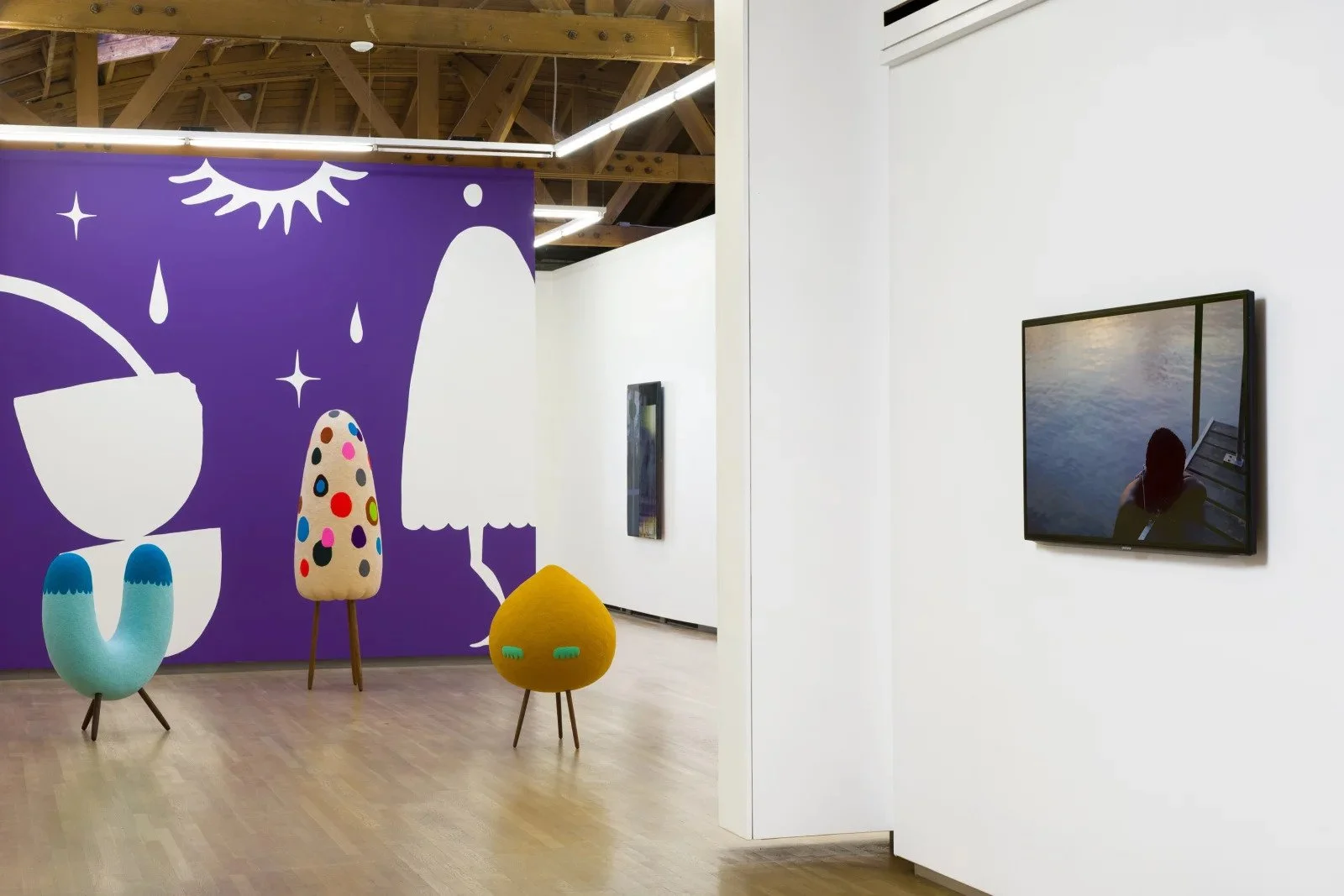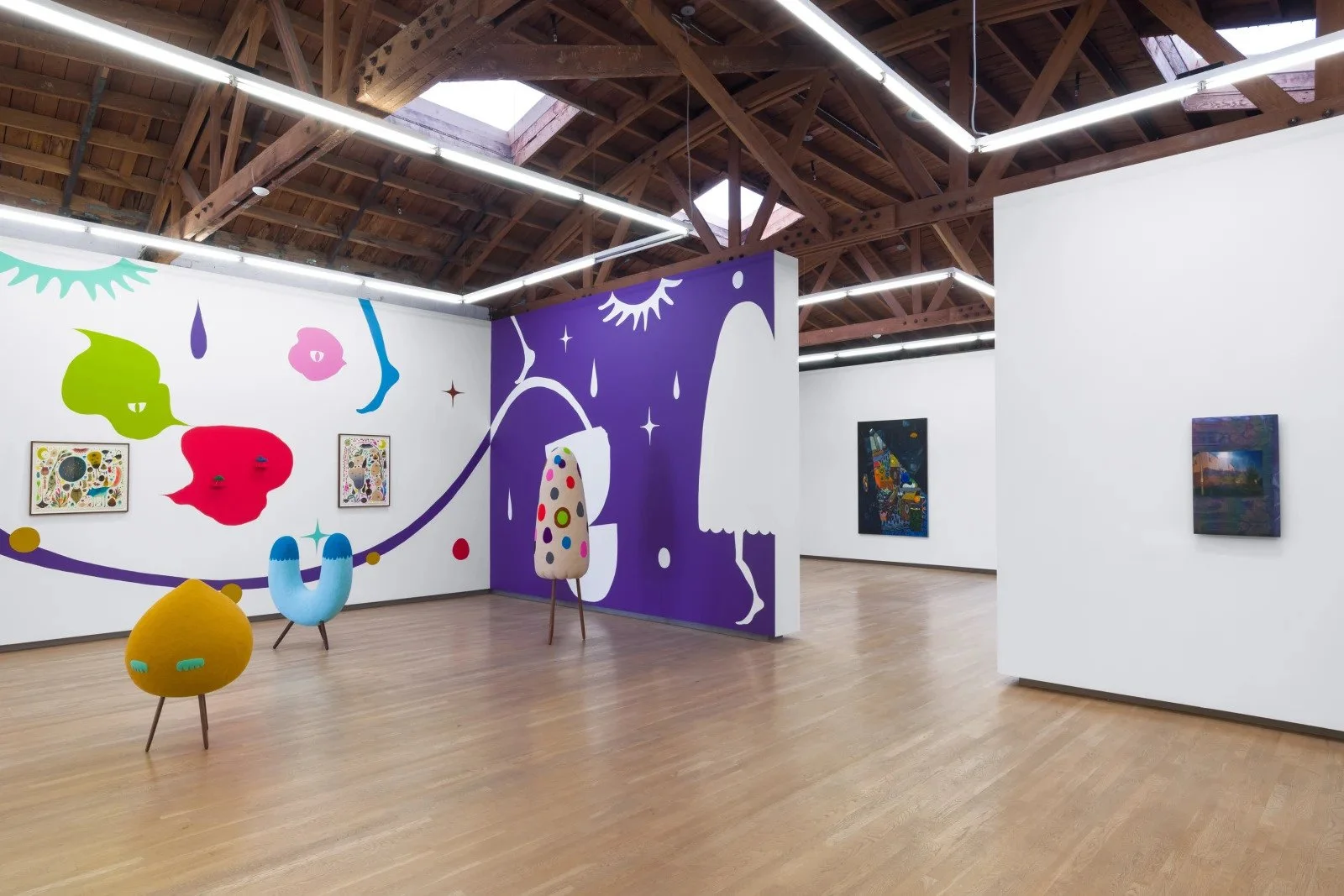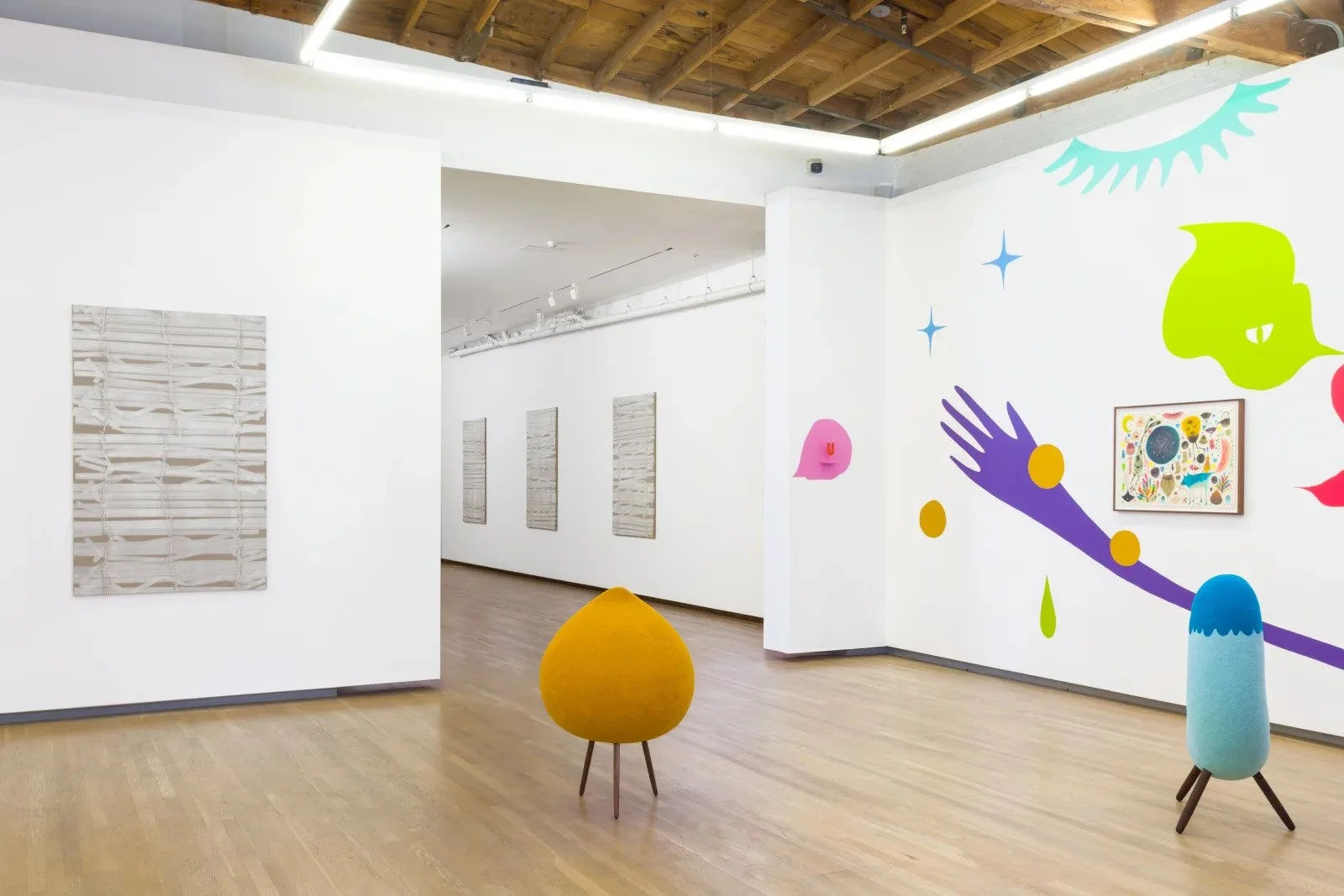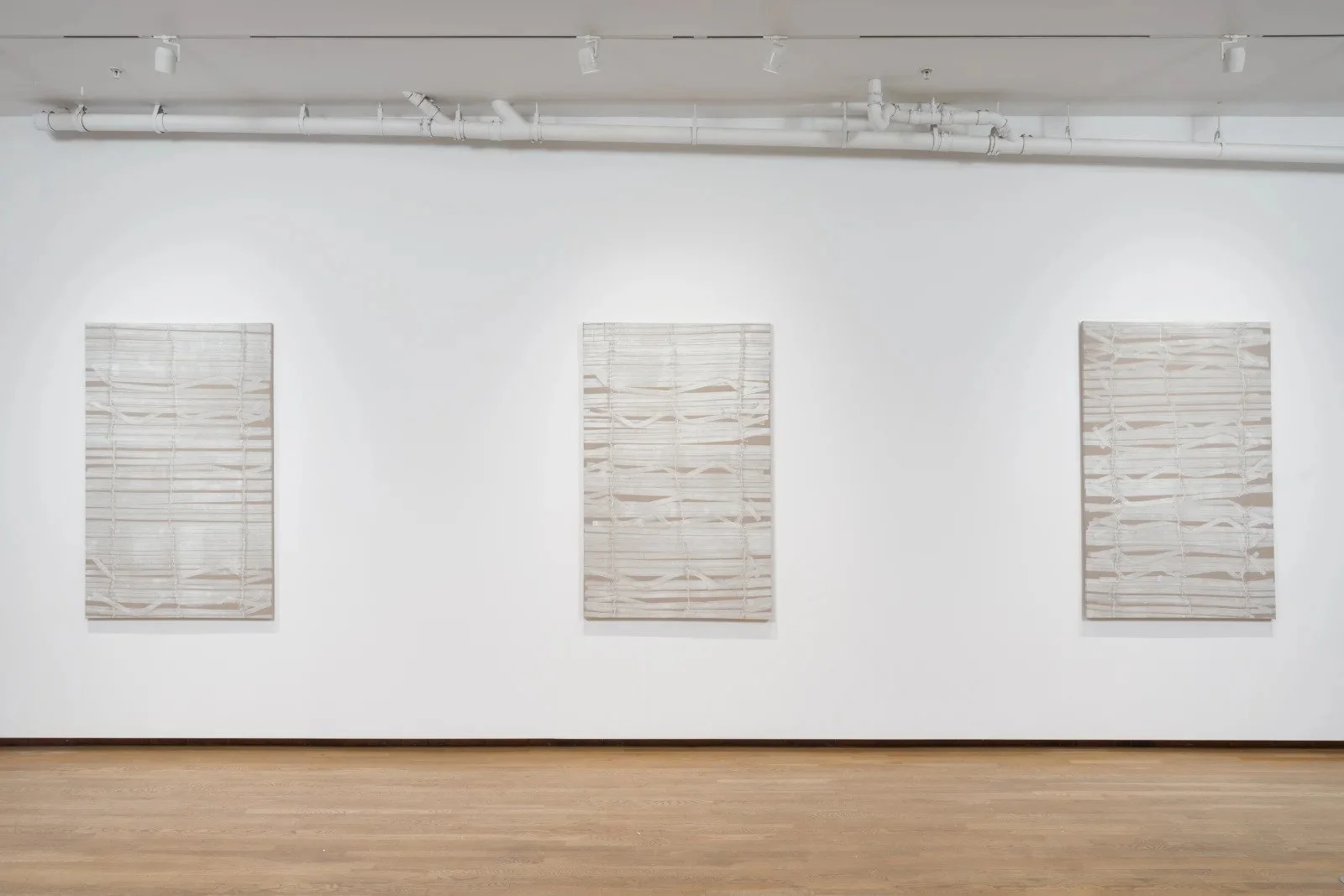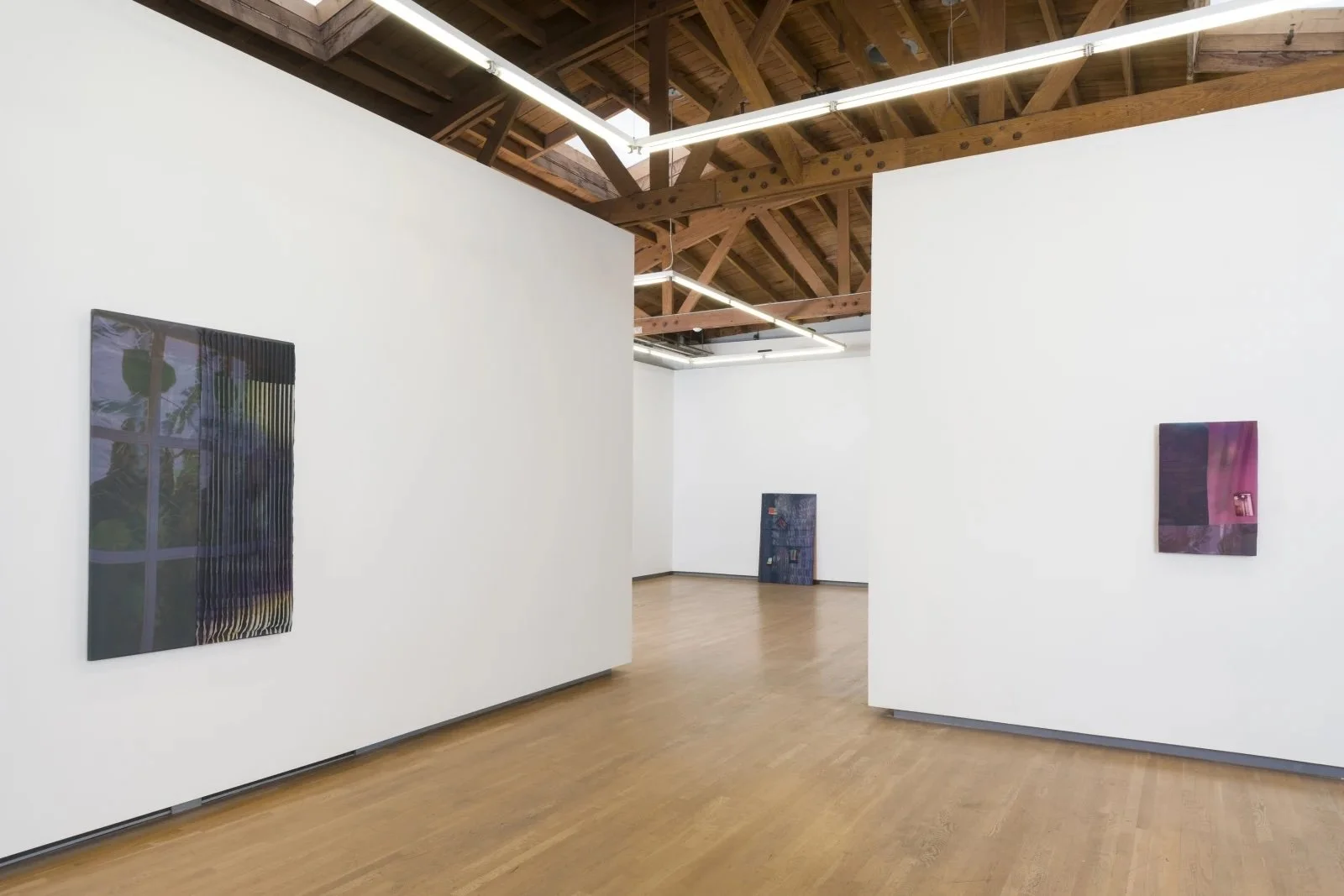Janaye Brown, Nicole Coson, Dickon Drury, Masako Miki, Emma Safir, and Mikey Yates
May 21-June 25, 2022
Curated by Patricia Cariño Valdez
Shulamit Nazarian is pleased to present Midnight Murmurs, a group exhibition featuring Janaye Brown, Nicole Coson, Dickon Drury, Masako Miki, Emma Safir, and Mikey Yates.
The artists in Midnight Murmurs ruminate on the quiet and intimate moments, secrets, and untold stories that occur behind the scenes in the late hours of the evening. It encompasses the conversations, obsessions, and rumblings of memories and anxieties that keep us up at night and linger in our minds throughout the waking hours. The exhibition features depictions of dimly lit domestic spaces, intimate late-night conversations, and the surreal moments that occur when the mind slips from reality into a dream state, rendered through a variety of media, including video, printmaking, painting, photography, sculpture, and installation. Midnight Murmurs heighten moments of friction that exist during a time when our bodies ought to rest. Together, the works reveal how the night is full of mystery and potential that will shape our consciousness in the mornings to come.
For the past decade, Janaye Brown's video practice has captured the pregnant moments she observes in everyday life. Through an extended look at a narrative fragment, Brown makes prominent the subtleties in interactions, opening the viewer to examine the details within the mise-en-scène. In her intimate video, Bather, After Dinner (2016), Brown films a swimmer resting her body on a dock. The artist catches the soft light across the surface of the water and the relaxing sound of it lapping on the pier, marking the sunset and the earth's transition from daytime to night. As the seemingly serene moment carries on, tension arises: the viewer anxiously anticipates what is to come, as the subject is lost in their own thoughts. Sound and moving image build and sustain the viewer's awareness while emphasizing the passage of time. Rocking the viewer to a meditative state, the artist summons a tone of mystery, leaving us suspect to the night.
Punctuated in the gallery are Nicole Coson's large-scale monotype prints from her Exoskeleton series. Created through a laborious process of painting each slat and chord, Coson runs the window dressings through an etching press, applying 3000 lbs of pressure per square inch. What results is a unique transfer of mangled blinds onto the canvas, monochromatic marks full of tension, stress, and breakage. Coson has based her new works on the proportions of a single window in the back of the gallery. Blinds, which serve as screens in our homes to conceal us from the outside world and vice versa, have been transformed by the artist into bodily forms that reference external skeletons. By exploring the familiarity of these interior accessories in their proxy form, Coson creates a sense of dislocation, toying with the grasp of our surroundings and negotiating the terms of visibility of what we choose to disclose and reveal.
The night often invokes suspicions of paranormal activities. Investigating this sentiment and the possible presence of otherworldly creatures are Masako Miki's brightly colored, felt sculptures and watercolor paintings. Miki creates abstracted figures that draw inspiration from Japanese traditions of Shinto beliefs, specifically yōkai (shapeshifters), deities, or preternatural creatures that disguise themselves into many forms. She references the Japanese folklore of Hyakki Yagyō(Night Parade of One Hundred Demons), ghosts, and shapeshifters that parade during the night. Some are known as Tsukumo-Gami, shapeshifters of rejected aged tools, or everyday household objects that become animated only in the late hours of the day, advocating for their existence after being unwanted. For the artist, these ancient narratives of spirits serve as a metaphor to explore our imaginations, blurring boundaries and questioning the very myths that guide our daily lives. Miki shares, “Because of their unique characteristics, they do not conform to accepted identities; instead, they generate new ones."
Grounding us in our bodies and our connection with kin are the diaristic paintings of Mikey Yates. Sourcing from memory and family photographs, Yates’ paintings center on his experience as a Filipino-American and explore having both parents and siblings enlisted in the military. Having to relocate every few years to cities across the world makes gathering together a rarity. In his paintings, Yates illustrates tender portraits of connection and normalcy that occur in the calmness of the late hours of the evening. Confessional in nature, these paintings recount conversations that occur with cousins on the rooftops and the silence in playing a simple game of chess with family. Apart from the hyper-focused events in the paintings, Yates's interior spaces are accessorized with belongings collected from across the world, decorating a temporary home while pointing to many places at once. The artist's work, rooted in the personal, renders cultural hybridity, storytelling, and delicate markers of important and lasting memories that influence one's framework for joy, happiness, and hope for the future.
Dickon Drury's hyper-saturated, large-scale paintings render unpopulated interior landscapes packed with accessories of books, computers, kitchenware, opened food, and beverages, reminiscent of a person frantically preparing for an uncertain tomorrow. Unnatural light reflects and refracts from various surfaces, and stark shadows create a dynamic interior setting. In his stacked and flattened paintings, the artist reveals a bounty of visual markers that speak to the possible inhabitant. Light casts from open microwaves, brightly lit screens on laptops, and vintage lava lamps highlight an eccentric scene that mimics the occupied mind—one that is active, awake and refuses to remain still. Attempting to make sense of the scene, the viewer ponders what these remnants say about the house guest. Drury’s work speaks to the obsessive nature and anxieties of the day and a desire to control a world that feels chaotic. Through his oil paintings, he bends and skews the domestic space, reinforcing how the night's emptiness amplifies the restlessness of our minds and spaces.
A restful night benefits our ability to retain information; however, in that transitional phase, there are moments when our experiences persist and appear as abstracted dreams or amorphous memories. For the last several years, Emma Safir has explored connections between real and imagined memory, mediated through photography. Building a photo archive of spaces that she does not have physical access to, Safir captures when areas are blocked by curtains, windows, other buildings, or fences. Stretching, layering, and sewing these images in modular ways, Safir creates soft objects that pixelate a specific location, both named and unnamed. The works call to mind the fractured understanding of specific events. Enhancing this dissonance is her strategy of both layerings of the silk image and neoprene material and photographic digital collage work, which generate a moiré effect. In this optical illusion, lines and images are superimposed on another, resulting in a strange, wavy pattern. These mixed-media sculptures with varying volumes resemble upholstered furniture or television. The works hang and lean, floating just enough to emanate a glow back onto the wall. Safir's practice plays with our perception of the object and transience of memories through material manipulation, illustrating surreal perceptions that replicate the dazed delusion of a late evening.
Artist Bios
Janaye Brown (b. 1987 San Jose, CA; Lives & Works in Berlin, Germany) has exhibited at venues and film festivals, including Wassaic Project, Wassaic, NY; New York City's Studio Museum Harlem; Anthology Film Archives, New York, NY; the Dallas Video Fest; The Banff Centre in Alberta, Canada; Crosstown Arts, Memphis, TN; and Shulamit Nazarian, Los Angeles, CA. Residencies and awards include Lademoen Kunstnerverksteder, Trondheim, Norway (forthcoming); AIR Konstepidemin, Gothenburg, Sweden (forthcoming); KulttuuriKauppila Art Centre Residency, Ii, Finland (forthcoming), the Skowhegan School of Painting and Sculpture, Madison, ME; Fiskars AiR, Fiskars, Finland; the Bruce High Quality Foundation University, New York, NY, and Crosstown Arts, Memphis, TN. Brown received an MFA in Studio Art from the University of Texas at Austin in 2013 and her BA in Cinematic Arts and Technology from California State University Monterey Bay in 2010.
Nicole Coson (b. 1992, Manila, Philippines; Lives and works London, UK) is a London-based Filipino artist. She received a BA in Fine Art from Central Saint Martins with first degree honors in 2014 and received her MFA from the Royal College of Art in 2020. She was selected for Bloomberg New Contemporaries 2020. Coson was also featured in Saatchi Gallery's London Grads Now exhibition last year. She has had solo exhibitions at Ben Hunter Gallery, London, UK; Silverlens Galleries, Manila, Philippines; Galerie Untilthen, Paris, France; and Annka Kultys Gallery, London, UK. She has participated in group exhibitions at South London Gallery, London, UK; Hales Gallery, London, UK; Silverlens Galleries, Manila, Philippines; Artist Room, London, UK; Fold Gallery, London, UK; Brigade Gallery, Copenhagen, Denmark; Center for Book Arts, New York; and Cultural Center of the Philippines, Manila.
Masako Miki (b. 1973 Osaka, Japan, Lives and works in Berkeley, CA) received her BFA from Notre Dame De Namur University in 1996 and her MFA from San Jose State University in 2001. She has had solo exhibitions at KMAC Museum in Louisville, KY (forthcoming); Institute of Contemporary Art San Jose, CA (forthcoming); The Watermill Center, Water Mill, New York; Ryan Lee, New York City; the de Young Museum, San Francisco, CA; and CULT Aimee Friberg Exhibitions, San Francisco.In 2021, Miki completed a public art installation of nine bronze sculptures commissioned for Uber Technologies’ HQ in San Francisco. She completed an outdoor sculptural installation at the coastal cultural park in Shenzhen, China. Currently, Miki is developing functional sculptures for the Minna-Natoma Art Corridor Project with the San Francisco Museum of Modern Art. Artist residencies include Kamiyama Artists in Residency, Tokushima, Japan; Facebook Artist in Residence, Menlo Park, CA; and the de Young Museum, San Francisco. Her work is held in several private and public collections including Berkeley Art Museum and Pacific Film Archive, Facebook, The Byrd Hoffman Watermill Foundation, and ColecciónSolo in Madrid Spain.
Mikey Yates (b. 1992 Sulzbach-Rosenberg, Germany; Lives and works in Kansas City, MO) received a BFA from Missouri State University and an MFA from the University of Colorado, Boulder in 2021. His works have been shown at Steven Zevitas Gallery, Boston, MA; Taymour Grahne Projects, London, UK; RULE Gallery, Marfa, TX; The Museum of African Contemporary Art Al Maaden, Marrakech, Morocco; and CU Boulder Art Museum, Boulder, CO. He has been featured in BOOOOOOOM!,YNGSPC & Friend of the Artist, and was featured in the MFA annual issue of New American Paintings, curated by Beth Rudin DeWoody.
Dickon Drury (b.1986, Salisbury, UK, Lives and works in London) received a BFA in Fine Art Painting at Falmouth College of Art in Cornwall, UK and in 2016, he received an MFA in Painting at The Slade School of Fine Art in London, UK. Solo shows includeTo Be The Key, Galleri Opdahl, Stavanger in 2020, The Who‘s Who of Whos at Koppe Astner, Glasgow in 2016, IF THE SEA WAS WHISKEY at Frutta, Rome 2017, and Holed Up at Galleri Opdahl, Stavanger, Norway in 2018. Exhibitions also include a solo presentation at Carlos Ishikawa for CONDO London and at Kendall Koppe Gallery in Glasgow, Scotland in 2021.
Emma Safir (b. 1990 New York City; Lives and works in Brooklyn, NY) received a BFA in 2012 from the Rhode Island School of Design in Printmaking and an MFA from the Yale School of Art in Painting & Printmaking in 2021. She has recently had solo exhibitions in New York City at Baxter St at Camera Club of New York; SHIN HAUS at Shin Gallery; and participated in group exhibitions at Lyles & King, New York, NY; TW Fine Art, Palm Beach, FL; and Pentimenti Gallery, Philadelphia, PA. She is currently an Artist in Residence at the Textiles Art Center in Brooklyn, a participant in the Interdisciplinary Art and Theory Program in Manhattan, and a Keyholder Resident at the Lower East Side Printshop in Manhattan.


